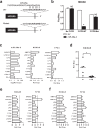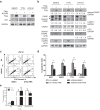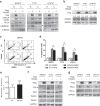Induction of p53-independent apoptosis by ectopic expression of HOXA5 in human liposarcomas
- PMID: 26219418
- PMCID: PMC4518222
- DOI: 10.1038/srep12580
Induction of p53-independent apoptosis by ectopic expression of HOXA5 in human liposarcomas
Abstract
Dedifferentiated liposarcoma (DDLPS) is a highly malignant subtype of human liposarcoma (LPS), whose genomic profile is characterized by chromosomal amplification at 12q13-q22. miR-26a-2 is one of the most frequently amplified genes in the region, and inhibition of its downstream target genes likely contributes to LPS tumorigenesis. Our previous study of LPS predicted homeobox protein A5 (HOXA5) as a target of miR-26a-2, and here we explored further the function of HOXA5, and its relationship with miR-26a-2 in DDLPS cells. Compared to normal human adipocytes, all LPS cell lines showed significant downregulation of HOXA5 (p = 0.046), and inhibition of miR-26a-2 using anti-miR-26a-2 substantially upregulated HOXA5 expression in these LPS cells. Interestingly, overexpression of HOXA5 alone induced very strong apoptotic response of LPS cells. HOXA5-induced apoptosis was p53-independent and caspase-dependent. Surprisingly, overexpression of HOXA5 induced nuclear translocation of RELA (p65), which was not associated with the transcriptional activity of RELA. Rather, nucleolar sequestration of RELA was observed. Overall, our study demonstrated for the first time that the downregulation of HOXA5 in LPS cells, partly by overexpression of miR-26a-2 in DDLPS, confers LPS cells resistance to apoptotic death. Further studies are required to understand the relationship of HOXA5 and the NFκB pathway in LPS cells.
Figures





Similar articles
-
Characterization of the 12q amplicons in lipomatous soft tissue tumors by multiplex ligation-dependent probe amplification-based copy number analysis.Anticancer Res. 2015 Apr;35(4):1835-42. Anticancer Res. 2015. PMID: 25862836
-
Overexpression of miR-26a-2 in human liposarcoma is correlated with poor patient survival.Oncogenesis. 2013 May 20;2(5):e47. doi: 10.1038/oncsis.2013.10. Oncogenesis. 2013. PMID: 23689287 Free PMC article.
-
HOXA5-induced apoptosis in breast cancer cells is mediated by caspases 2 and 8.Mol Cell Biol. 2004 Jan;24(2):924-35. doi: 10.1128/MCB.24.2.924-935.2004. Mol Cell Biol. 2004. PMID: 14701762 Free PMC article.
-
The emerging roles and therapeutic potential of microRNAs (miRs) in liposarcoma.Discov Med. 2015 Nov;20(111):311-24. Discov Med. 2015. PMID: 26645903 Review.
-
Regulation of the MIR155 host gene in physiological and pathological processes.Gene. 2013 Dec 10;532(1):1-12. doi: 10.1016/j.gene.2012.12.009. Epub 2012 Dec 14. Gene. 2013. PMID: 23246696 Review.
Cited by
-
Aspirin Prevention of Colorectal Cancer: Focus on NF-κB Signalling and the Nucleolus.Biomedicines. 2017 Jul 18;5(3):43. doi: 10.3390/biomedicines5030043. Biomedicines. 2017. PMID: 28718829 Free PMC article. Review.
-
HOXA5-Mediated Stabilization of IκBα Inhibits the NF-κB Pathway and Suppresses Malignant Transformation of Breast Epithelial Cells.Cancer Res. 2022 Oct 17;82(20):3802-3814. doi: 10.1158/0008-5472.CAN-21-4277. Cancer Res. 2022. PMID: 36166646 Free PMC article.
-
Homeobox Genes in Cancers: From Carcinogenesis to Recent Therapeutic Intervention.Front Oncol. 2021 Oct 14;11:770428. doi: 10.3389/fonc.2021.770428. eCollection 2021. Front Oncol. 2021. PMID: 34722321 Free PMC article. Review.
-
An Insight into the Roles of MicroRNAs and Exosomes in Sarcoma.Cancers (Basel). 2019 Mar 26;11(3):428. doi: 10.3390/cancers11030428. Cancers (Basel). 2019. PMID: 30917542 Free PMC article. Review.
-
Small Non-Coding RNAs in Soft-Tissue Sarcomas: State of the Art and Future Directions.Mol Cancer Res. 2023 Jun 1;21(6):511-524. doi: 10.1158/1541-7786.MCR-22-1008. Mol Cancer Res. 2023. PMID: 37052491 Free PMC article. Review.
References
-
- Singer S. et al. Gene expression profiling of liposarcoma identifies distinct biological types/subtypes and potential therapeutic targets in well-differentiated and dedifferentiated liposarcoma. Cancer Res 67, 6626–6636 (2007). - PubMed
-
- Ray-Coquard I. et al. Effect of the MDM2 antagonist RG7112 on the P53 pathway in patients with MDM2-amplified, well-differentiated or dedifferentiated liposarcoma: an exploratory proof-of-mechanism study. Lancet Oncol 13, 1133–1140 (2012). - PubMed
-
- Gesta S., Tseng Y. H. & Kahn C. R. Developmental origin of fat: tracking obesity to its source. Cell 131, 242–256 (2007). - PubMed
Publication types
MeSH terms
Substances
LinkOut - more resources
Full Text Sources
Other Literature Sources
Research Materials
Miscellaneous

